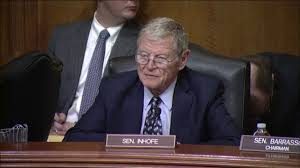
Fifteen years after Oklahoma Sen. Jim Inhofe’s so-called EPA “midnight rider” won approval on a highway funding bill, it paid off for Oklahoma. And environmentalists don’t like it.
We’ve learned more details about the EPA’s decision to let Oklahoma enforce environmental rules and regulations in the wake of the U.S. Supreme Court decision that stripped the state of land now considered to be Indian reservation land.
POLITICO unveiled some of the details this week reporting that a “little-known 15-year-old law enabled Oklahoma to sidestep some of the fallout from this summer’s sweeping Supreme Court ruling.”
The high court’s McGirt decision meant that huge swaths of the state were suddenly under tribal jurisdiction, not the state government’s — including oversight of tens of thousands of oil and gas wells, as well as coal-fired power plants, refineries and other industrial sites. That spawned questions about whether the tribes might hike taxes or implement more stringent environmental regulations.
But a provision tucked into the 2005 SAFETEA highways bill by Sen. Inhofe (R-Okla.) said that if Oklahoma — and Oklahoma only — asks EPA to let it administer environmental programs in Indian country, the agency must approve it. Fifteen years later, Inhofe’s “midnight rider,” as it came to be known, has paid off big time.

As OK Energy Today reported earlier this week, weeks after the Supreme Court’s decision, Gov. Kevin Stitt wrote to EPA Administrator Andrew Wheeler to invoke the law and regain regulatory control over programs under the Clean Air Act, Clean Water Act and other environmental laws in the eastern half of the state, including Tulsa.
EPA last week approved that request, according to an Oct. 1 letter from Wheeler.
“EPA’s letter resolves ambiguity and essentially preserves the regulatory status quo in Oklahoma,” said agency spokesman James Hewitt. He noted the state still has some other lands controlled by tribes or EPA directly, and said tribes can apply for “Treatment as a State” status to gain regulatory oversight.
Notably, the SAFETEA law also requires the tribes seeking that recognition to first obtain a “cooperative agreement” with Oklahoma “to jointly plan administer program requirements.”

“It is status quo, but it’s status quo that comes with an insult,” said Al Armendariz, deputy regional director for the Sierra Club’s Beyond Coal campaign and a former regional EPA chief in the Obama administration.
“Although the tribes now are looking at kind of a renaissance of asserting jurisdiction, of establishing laws, of getting to govern these reservations that everybody thought were abolished a century ago, they can’t do that now on environmental protection, clean water, streams, clean air, climate change — because of Sen. Inhofe,” Armendariz said.

Armendariz was supported by Johnson Bridgwater, director of the Oklahoma Chapter of the Sierra Club.
“Following the recent McGirt Decision by the U.S. Supreme Court, the EPA had an opportunity to do the right thing by over-turning Senator Inhofe’s underhanded anti-tribal legislative authority sought and approved in 2005. Instead, the EPA quietly and swiftly made the decision, without any public input process, to let the State of Oklahoma continue to walk on the rights of Oklahoma tribes—shame on the EPA and shame on the State of Oklahoma.”
Bridgwater said his organization completely disagrees with the EPA decision.
“—and we want to point out that the only winner here is an oil and gas oligarchy that runs this state….We believe state government should focus on protecting democracy and the interests of its citizens, not big business.”
Full disclosure: Inhofe in 2012 prompted Armendariz’s resignation from EPA after publicizing his 2010 comments promising to “crucify” oil and gas companies that violated environmental laws.
Source: POLITICO





